|
Click here
for a photo album of Grandma's Yellow Rose
What are the characteristics which make a plant a "winner"?
Some are vitally important such as (1) It must be attractive and
useful to the gardening masses rather than a special few who devote
themselves to one specific plant type; (2) It must consistently
perform well for Texas consumers regardless of their plant growing
expertise; (3) It must be able to be propagated and mass-produced
in sufficient numbers to meet the increased consumer demand generated
caused by the great performance of the plant; (4) It must be unique
and/or offer desirable and ornamental characteristics which are
not usually available in commonly sold plants; (5) It must be
as pest resistant as possible---an added bonus is to be a non-preference-to-deer
plant; and, most importantly, (6) It must be attractive in the
sales container -- so attractive that it sells itself to the consumer
who has never heard of the many attributes of the plant.
Since the beginning of the Texas SuperStar Plant introduction
program in the fall of 1989 through spring of 2007, there have
been 40 plants introduced and promoted to the Texas public. Four
plants were million-dollar sellers (Satsumas, ‘Gold Star'
Esperanza, Perennial Hibiscus and ‘Belinda's Dream' Rose
which was promoted during the spring (April), '2002 ----- Belinda's
Dream (Rosa x 'Belinda's Dream) - Combination old-fashioned and
hybrid Tea with fragrance and durability.) for the Texas nursery
industry within 4 years of their introduction.
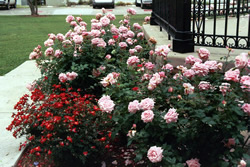
Belinda's Dream (pictured here with red 'Knockouts') was the first
Texas' SuperStar rose in 2002.
We began statewide trialing in 1998 even though Belinda's Dream
(Rosa x 'Belinda's Dream) was not declared the first Texas SuperStar
rose until April, '2002. The reason for this was simple—one
shouldn’t promote a new rose – which looks like the
traditional Valentine rose-- in all Texas’ metropolitan
areas until there are hundreds of thousands of plants to supply
the demand generated. If not, consumers are disappointed and suppliers
are angered.
'Belinda's Dream' is not purely an old-fashioned or antique rose.
Many people have been misled into believing that because antique
roses are old, they are disease resistant. Many of the antique
roses can survive without pesticide sprays. However, the quality
of bloom, especially for cut flowers, produced by antique roses
cannot equal and is not acceptable to most people who want a rose
which can be used as a Valentine rose. If someone is going to
grow roses, they want the flower produced to resemble that which
most people consider to be a rose. 'Belinda's Dream' rose looks
like a real rose BUT has the toughness of the antiques or old-fashioned
types. Much of this toughness comes from the fact that ‘Belinda’s
Dream’ is propagated from rooted cuttings so the plants
are growing on their own root system. This enables a plant to
be cut to the ground, or frozen to the ground, and what resprouts
will be the same beautiful rose. Grafted roses are the most commonly
sold. These plants are grown on a rose root stock which if allowed
to grow over the scion (grafted desirable rose variety) will produce
a large, rambling bush with poor quality blooms.
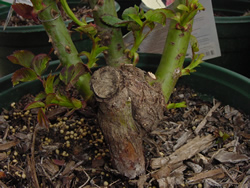
Grafted roses are grown on a wild rose rootstock (center, larger
stem) which has an undesirable bloom.
Typically hybrid roses are propagated by budding (See:
http://aggie-horticulture.tamu.edu/citrus/budding/budding.htm
http://aggie-horticulture.tamu.edu/propagation/budding/budding.html)
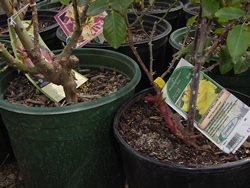
'Grandma's Yellow' (right) is grown on its own roots compared
to the grafted rose (left). Sprouts from the root system come
true and produce more beautiful yellow roses.
onto a known rootstock since it requires less stem
growth (which has many buds per stem) as opposed to the old stem-rooting
technique used for antique roses as described at: http://www.plantanswers.com/rose_propogation.htm
and http://aggie-horticulture.tamu.edu/southerngarden/roseprop.html
In 1996 ‘Belinda’s Dream’ wasn’t even
being promoted when a group of horticulturists consisting of Jerry
Parsons, Greg Grant and Larry Stein began looking for a yellow
rose for Texas. Regardless of how superior a Texas SuperStar plant
is, some people always want a different color. The color yellow
in the rose family usually results in a weak plant which is very
susceptible to diseases. We knew we had taken on a difficult task
since every rose breeder in the world is trying to create a vigorous,
disease-resistant yellow rose.
We decided to look for yellow rose plants which had lived for
a long time in their initial planting areas so we were looking
for large, long-lived yellow rose bushes. We gave them names of
the locales in which they were found. The yellow rose bush which
gave Parsons this idea was located in Sabinal, Texas, and was
named “Sabinal”. “Sabinal” was a beautiful
yellow rose but it was difficult to root. Remember, one of the
main elements of being made a Texas SuperStar is: “It must
be able to be propagated and mass-produced in sufficient numbers
to meet the increased consumer demand generated”.
Other possible yellow rose candidates were found in Nacogdoches
(growing and blooming beneath an abandoned motel overhang) and
Seguin (growing in a bed of roses all labeled as red roses) and
so named. A third candidate was found at a retired school teacher’s
(named Sarah Johnson) home near Nacogdoches and was named “Sarah
Jones” (because Greg Grant and Parsons did not remember
her last name correctly!). A modern hybrid tea named ‘Midas’
was rooted and tested as well as the hybrid named ‘Sun Brite’
which was recommended by Dr. Sam McFadden of Somerville, Tennessee,
as being the most disease-resistant of all the yellow roses he had tested.
The final yellow rose tested was found by Parsons and Stein,
at different times, on a street in southwest San Antonio named
“Brady”. “Brady” and “Seguin”
were almost identical in color and fragrance but “Brady”
was very difficult to root.
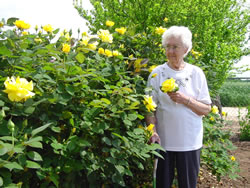
Dr. Larry Stein's grandmother, Tillie Jungman, after whom 'Grandma's
Yellow' was named LOVED the yellow roses.
All of the yellow rose candidates were propagated and six plants
of each (“Seguin”, ‘Midas’, “Nacogdoches”
and “Sarah Jones” were planted in spring of 1998 around
the garden of Larry Stein’s maternal grandmother ( Clotilda
Mary (Tillie) Jungman ) who lived near Castroville. The garden
area had a soil pH of 8.2 and, since these plants were growing
on their own root system, would get a real test to see if they
could uptake minor elements such as iron. The plants were never
sprayed for insects or disease but were fertilized and watered
normally. ‘Belinda’s Dream’, ‘Easy Going’
(rooted and grafted plants) which was being considered for a SuperStar,
and a highly disease susceptible red rose were planted along the
same garden.
After a year or so, we realized that four of the original “Nacogdoches”
plants were weak and more prone to disease. However, two plants
were thriving, had an awesome flower and seemed more disease resistant.
Greg Grant confirmed these plants “were different”
from the other four. With that confirmation, cuttings were made
of these plants and rooted. Mutations or sports in buds and stems
have produced many of the superior horticulture plants we enjoy
today. A darker red ‘Red Delicious’ apple was found
growing on a stem of the original ‘Red Delicious’
apple. White-fleshed peaches can be found growing on yellow-fleshed
peach varieties. Dwarf sports can be found on standard-growing
plants, i.e., ‘Katy Dwarf’ Ruellia was found growing
on a large plant of Ruellia known as Mexican Petunia. So this
is not an unheard of occurrence.
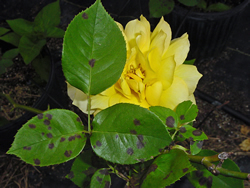
Black Spot Disease resistance was evaluated. This yellow rose
is very susceptible and was eliminated.
From the 4-year (1999-2003) study in Larry Stein’s grandmother’s
garden, we concluded that “Seguin”, “Sarah Jones”
and “Nacogdoches” had the best soil pH and disease
tolerance. Even when the red rose was completely defoliated with
black spot fungus disease, these yellow roses were clean.
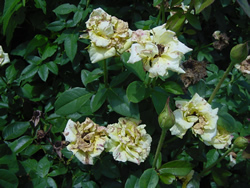
All stages from deteriorated blooms to new buds in the '07 rainy
spring at College Station did not cause black spot damage on ‘Grandma’s
Yellow’.
We first chose “Seguin” as our candidate for Texas
SuperStar because it was much more fragrant than “Nacogdoches”.
However, when trial plants of these three selections were distributed
to various growers and nurserymen for testing, the “Nacogdoches”
was voted best because of disease resistance, ease of propagation
and beauty of bud and flower. The “Seguin” yellow
rose also displayed a “mysterious death” syndrome
in many locations. “Sarah Jones” was more black spot
susceptible in the San Antonio area than “Seguin”
or “Nacogdoches” but it seems to have less disease
in East Texas.
After Miss Tillie died on November 27, 2005, the name “Nacogdoches”
was changed to ‘Grandma’s Yellow’ in honor of
Larry Stein’s grandmother who had let us use her garden
and came to truly love these yellow roses. She once told me she
loved me almost as much as she did Larry because I planted her
all of those beautiful yellow roses. Larry took roses to her room
every day as long as the plants were blooming. However, when we
had to prune the roses (while she was watching her favorite soap
opera!!) she told me that I had dropped off of her most-favorite-person
list. I tried to tell her that Greg Grant had done most of the
cutting but I don’t think I was fully forgiven. We made
up later. As I sat in the church at her funeral, the thought came
to me that we should name the Texas SuperStar yellow rose in her
honor. As the pallbearers entered and each had a yellow rose bud
in their lapel, the thought came to me: “Got any questions
about the name change?!” At that moment, “Nacogdoches”
became ‘Grandma’s Yellow’ and will remain so
forever---as directed.
Since the beginning of this yellow rose for Texas (and the U.S.
since it has done well in Tennessee for Dr. McFadden and friends)
project, we knew the demand for this rose was going to be even
more than the demand for ‘Belinda’s Dream’ because
EVERYBODY WANTS A YELLOW ROSE!! We had learned an interesting
fact when we were propagating ‘Belinda’s Dream’.
That fact is that plantlets produced from tissue culture had reverted
back to a juvenile state and root twice as fast as standard cuttings.
Dr. Dan Lineberger was the person who revealed this information
when we were doing the ‘Belinda’s Dream’ propagation.
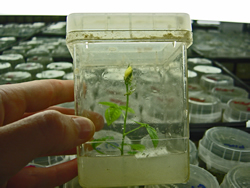
'Grandma's Yellow' Rose WANTS TO Bloom even in tissue culture
in a test tube.
After we had made the choice of ‘Grandma’s Yellow’,
he immediately put the plant into tissue culture. After he had
grown sufficient stock plantlets, he turned the project over to
a commercial laboratory under the direction of a former student
named April Herring, Production Manager of Tissue Culture, Magnolia
Gardens Nursery (Cell: 281-705-7724; Office: 281-356-1213; FAX:
281-356-5326) See their websites at: www.magnoliagardensnursery.com
and www.plantsfortexas.com
In 2006, the largest commercial wholesale nurseries in Texas purchased
over 10,000 tissue culture rose plugs which will produce the millions
of fast rooting cuttings needed to grow own-rooted, virus-tested
‘Grandma’s Yellow’ roses.
That is the history of ‘Grandma’s Yellow’; now
let me tell you about the rose that is ‘Grandma’s
Yellow’. It is not perfect!! But it is mighty close!! And,
as the manager of Greenleaf in El Campo so eloquently put it:
“It is not perfect but it is the best yellow rose available
at this time”. This is a rose which does not need constant
spraying to survive and produce lovely yellow Valentine-like blooms.
Leaf infection of this yellow rose variety with black spot fungus
and powdery mildew (white powder-like substance) on the leaves
will occur when conditions are most favorable for disease. Black
spot is the biggest disease problem of roses. This fungal disease
appears on the leaves as circular black spots with fringed edges.
The leaves may turn yellow and drop prematurely. Prevent this
disease by 1) eliminating excess water on the foliage when irrigating
and 2) by regular spraying of an approved fungicide. According
to several professional rose growers, Funginex (Triforine) or
bayleton (FungAway) are the best fungicides for black spot. Organic
growers can try Rose Defense (Neem oil), sulfur, and organic insecticides.
During heavy disease pressure periods (usually early spring) begin
a disease prevention program every 7-10 days until drier conditions
occur—usually 3 or 4 consecutive sprays in the spring is
all that is needed. If you do not want to ever protect the foliage,
‘Grandma’s Yellow’ WILL survive, WILL RESPROUT
FOLIAGE, and WILL produce an abundance of quality flowers when
conditions allow and if proper watering and fertilization occur.
It produces successive flushes of bloom -- from spring until frost
-- and is so disease tolerant that fungicide sprays are seldom
required. It is an outstanding performer even in highly alkaline
clay soils. A WARNING: ‘Grandma’s Yellow’ does
not appreciate neglectful growing practices such as seldom watering
and low fertility. If you feel you must neglect your rose plants
all the time, PLEASE DO NOT PLANT A PRECIOUS ‘GRANDMA’S
YELLOW’!!! Follow instructions for culture provided under
Rose Care and Fertilization at:
http://aggie-horticulture.tamu.edu/plantanswers/publications/roses/rose.html
Pruning is optional but recommended. Prune this rose as you would
any hybrid tea.
Common Name
‘Grandma’s Yellow (Formerly “Nacogdoches”)
Classification
Shrub-- The deep yellow-flowering Grandiflora rose named ‘Grandma’s
Yellow’ is upright and bushy. Most antique yellow roses
have a light yellow—almost pale flower. ‘Grandma’s
Yellow’ is a real knockout. Its new leaves have a shade
of bronze, then turn dark green. Flowers have a light and spicy
fragrance. With full sun, it reaches 4 feet to 5 feet in height
and 3 feet width. It is a repeat bloomer from spring until frost
and is quite disease resistant – the best disease resistance
of any yellow rose.
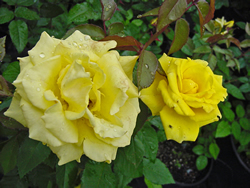
'Grandma's' flowers fade from deep yellow to pale yellow as they
mature.
Color
Deep Yellow
Number of Petals
17-25
Exposure
Full Sun
Spacing:
3 feet
Fertilizing:
Fertilize in spring just before new growth begins.
Cold Hardiness:
Hardy in zones 6 - 9
Water Use.
Keep moist until completely established. Average water needed
during growing season
Resistance to disease
Yes

'Grandmas' flowers are more fragrant when fully opened.
Fragrance
Light, spicy
Foliage
Dark Green bronze cast on new growth.
Growth
Upright, bushy
Bloom
Repeat, blooms from spring - frost
History:
Sport from buds hybrid tea or Grandiflora rose found growing in
Nacogdoches
Misc. Information
‘Grandma’s Yellow’ will become the "official"
“Yellow Rose for Texas”
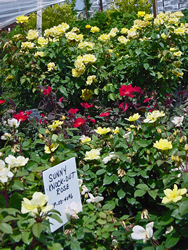
'Grandma's Yellow' in back clearly outblooms and is showier
than Sunny Knockout in front. |
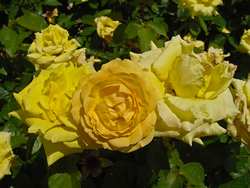
Julia Child' rose is buttery golden (center) compared to
the true yellow 'Grandma's Yellow' on either side. |
===============================================================
FIRST TEST MARKETED IN SAN ANTONIO
DURING THE WEEK OF FEBRUARY 12, 2007
A PRELIMINARY MARKETING STUDY
OF ‘GRANDMA’S YELLOW’ ROSE
IN SAN ANTONIO, TEXAS
DURING THE WEEK OF VALENTINE
FEBRUARY 12 - 16, 2007
Jerry Parsons, David Rodriguez and Larry Stein
‘Grandma’s Yellow’ Rose is scheduled to be
a Texas SuperStar release in SPRING (April) 2009 - Rosa ‘Grandma's
Yellow'
(Formerly “Nacogdoches” ("Yellow-Rose-for-Texas"
promotion)
http://aggie-horticulture.tamu.edu/plantanswers/butterflies/flowers/YellowRose.html
We had the opportunity to test the marketability of this rose
during the week of February 12, 2007, when Tracy Hobson Lehmann,
Express-News Home & Garden Editor, was gathering information
to write a front page column entitled: “A Dozen Roses -
Go ahead. Promise your sweetheart a rose garden. With these varieties,
you can deliver.” On the entire front page of the San Antonio
Life section, these dozen roses were listed, described and pictured.
A scanned page of this listing is attached. The dozen roses chosen
were (1) ‘Belinda’s Dream’ (April, 2002, first
Texas SuperStar rose - ‘Belinda's Dream’ (Rosa x 'Belinda's
Dream’) - Combination old-fashioned and hybrid Tea with
fragrance and durability); (2) ‘Knockout’ (April,
2004, third Texas SuperStar rose); (3) ‘Dame de Coeur’;
(4) ‘Mister Lincoln’ (Listed in the “The Dozen
Enduring Fragrant Roses” section of:
http://aggie-horticulture.tamu.edu/plantanswers/publications/roses/rose.html
); (5) ‘Ducher’; (6) ‘Mutabilis’; (7)
‘The Fairy’; (8) ‘Queen Elizabeth’ (Listed
in the “The Dozen Enduring Fragrant Roses” section
of PLANTanswers) (9) Gemini’; (10) ‘St. Patrick’;
(11) ‘Hot Tamale’ and (12) Tournament of Roses. To
get this list, Tracy interviewed: (1) Jackie Clark, San Antonio
Rose Society, who probably furnished selections 9, 10, 11 and
12; (2) Laverne Parker and Cindy Lawrey, Antique Rose Emporium
who DEFINITELY furnished selections 3, 5, 6, and 7; and (3) Kathy
Wolf, Rainbow Gardens who probably furnished selections 1, 2,
4, and 8 because they are available in large quantities from local
nurseries and are proven favorites. The information about these
dozen roses was published in the February 10, 2007, San Antonio
Life Section in the San Antonio Express-News.
Parsons happened to speak with Tracy on Friday before the story
was published on Saturday and mentioned that for the first time
a new yellow rose named ‘Grandma’s Yellow’ was
going to be available at only two nurseries (Fanick’s Nursery
on the Southside of San Antonio and Milberger’s Nursery
on the Northwest side of San Antonio). Tracy graciously agreed
to put the following information in the same section as the other
rose write-up but on the back page of the section and with a much
smaller picture -- a scan of the article is attached. The article
read:
=================================
Local nurseries sell new rose
Web Posted: 02/09/2007 04:55 PM CST
San Antonio Express-News
A limited number of a new yellow rose developed for Texas will
be available at two local nurseries Tuesday.
A total of about 100 plants of 'Grandma's Yellow' will be sold
at Milberger's Nursery and Landscaping and at Fanick's Nursery,
according to Jerry M. Parsons, a Texas Cooperative Extension horticulturist
who has helped to develop a quick-rooting yellow rose that thrives
in the Lone Star State.
'Grandma's Yellow,' a prolific bloomer, was developed from a hybrid
tea sport found in Nacogdoches, Parsons says. Commercial growers
are building stock of the plant, and a few have been sold at local
garden events.
Plants in 2-gallon containers will sell for $16.99.
For more information, call Milberger's at (210) 497-3760 or Fanick's
at (210) 648-1303.
=======================================
The availability of these roses was also mentioned several times
on the KLUP Radio (AM 930) on Saturday and Sunday from 12:00 p.m.
to 2:00 p.m. Because of the limited number of plants, their availability
was not mentioned on David Rodriguez’s garden show on WOAI-AM
1200 since his show has a much larger audience.
===================================================================
RESULTS: Over 900 plants were sold in 5 days during which the
two nurseries had to re-order 3 times during the week after having
sold the first plants they had within hours of the first day the
plants became available on Tuesday, as mentioned in the article.
This marketing study generated $7,425 (plants were wholesaled
at $8.25 each) to the wholesale nursery (Greenleaf) and it generated
$15,300 to the retailers which were Fanick’s and Milberger’s.
An interesting fact provided by Fanick’s Nursery was that
very few, if any, of the roses recommended on the front page were
sold - EVERY CUSTOMER WANTED THE YELLOW ROSE!!
CONCLUSION:
1. People want a yellow rose.
2. People want a rose which looks like the traditional Valentine
rose.
3. People will not buy, in quantity, any rose which does not
look like a traditional Valentine rose regardless of the hype
uses to promote it.
4. The overwhelming response from casually advertising these
roses on the back page of a newspaper section and on only one
radio garden show in San Antonio indicates that at least 25,000
should be available at all of the major wholesale nurseries before
it is heavily promoted in the San Antonio area alone. For a statewide
promotion including Dallas, Ft. Worth and Houston, we estimate
at least 500,000 plants should be available for sale.
5. The Texas SuperStar ‘Grandma’s Yellow’ Rose
release is
scheduled to be in SPRING (April) 2009 - Rosa ‘Grandma's
Yellow' (Formerly “Nacogdoches” ("Yellow-Rose-for-Texas").
With this much response in one week after a limited promotion
and since commercial growers are selling this product as fast
as they can produce it, we project the statewide promotion
may have to be delayed because of insufficient product to
service the tremendous demand for a good yellow rose.
|



